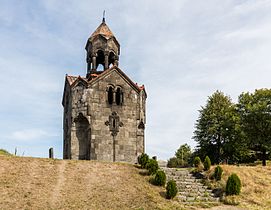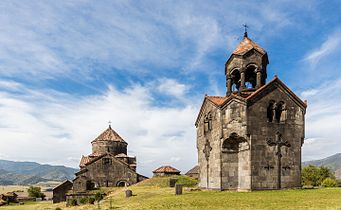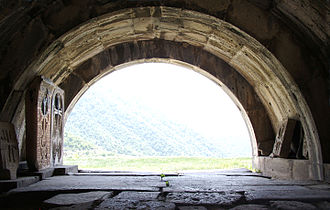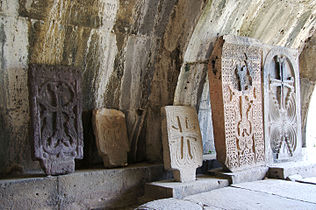Haghpat Monastery
| Haghpat Monastery Հաղպատավանք | |
|---|---|
 A view of Haghpat Monastery | |
| Religion | |
| Affiliation | Armenian Apostolic Church |
| Rite | Armenian Apostolic Church |
| Location | |
| Location | near Haghpat, Lori Province, Armenia |
| Geographic coordinates | 41°05′38″N 44°42′43″E / 41.093889°N 44.711944°E |
| Architecture | |
| Style | Armenian |
| Groundbreaking | 10th century |
| Official name: Monasteries of Haghpat and Sanahin | |
| Type | Cultural |
| Criteria | ii, iv |
| Designated | 1996 (20th session) |
| Reference no. | 777-001 |
| UNESCO Region | Western Asia |
Haghpat Monastery, also known as Haghpatavank (Armenian: Հաղպատավանք), is a medieval monastery complex in Haghpat, Armenia,[1] built between the 10th and 13th century.
Location

The location of Haghpat Monastery was chosen so that it overlooks the Debed River in northern Armenia's
History and description

The monastery was founded by Queen Khosrovanuysh, wife of the Bagratid king
Cathedral of Surb Nshan
The largest church in the complex, the
Apart from one or two minor restorations carried out in the eleventh and twelfth centuries, the church has retained its original character.Other structures
There are several other structures at the site as well. There is the small domed Church of
There are also a number of splendid khachkars (cross-stones) of the 11th-13th centuries standing on the territory of the monastery, the best known among them is the "Amenaprkich" (All-Savior) khachkar which has been standing since 1273.[8]
Crusades
In 1260,
Survival throughout history
The monastery has been damaged many times. Sometime around 1130, an earthquake destroyed parts of Haghpat Monastery and it was not restored until fifty years later. It also suffered numerous attacks by armed forces in the many centuries of its existence and from a major earthquake in 1988. Nevertheless, much of the complex is still intact and stands today without substantial alterations.[2][8]
-
Medieval notables of Haghpat
-
Mural representing Khutlubuga. Church of the Holy Sign. Haghpat Monastery, southern wall. Late 13th century.[6]
-
Deesis. Church of the Holy Sign. Haghpat Monastery. Wall painting in the semi-dome. Early 13th century.[16]
Significance, UNESCO World Heritage Site
Described as a "
The two monastic complexes represent the highest flowering of Armenian
Today the area is an increasingly popular tourist site.
Gallery
-
Thebelltower
-
The belltower and the Church of Sourb Nshan
-
Artistically carved entranceway to one of the buildings
-
Smbat II and his brother Kiurike Idepicted at the entrance to Haghpat Monastery
-
Dome (interior)
-
Monastery gate, looking from inside out; note stone crosses (khachkars) left and right
-
Monastery gate, stone crosses (khachkars)
-
Church interior, nave and altar
-
Library and scriptorium (storage jars were inserted into the floor when the room was later converted into a storeroom)
References
- ^ a b UNESCO, "Monasteries of Haghpat and Sanahin"
- ^ a b c "The monastery of Haghpat" by Elisabeth Baudourian, UNESCO Courier, May 1998
- ISBN 978-0810906259.
- ^ Armenica.org, "The Architectural Complex of Haghpat Monastery"
- ISBN 978-0-19-093588-7.
- ^ .
- ^ Nersessian, Sirarpie Der (1970). The Armenians. Praeger Publishers. p. 202.
The two brothers , Gurgen ( Kiurike I ) on the left and King Smbat II on the right , hold a model of the church . Smbat , as King of Ani , wears a large turban like the one worn later by Gagik I
- ^ a b c Sourb Nshan, Sourb Astvatsatsin, Sourb Grigor
- ^ Hasan Prosh, were required to besiege Mayyafariqin, the northernmost Ayyubid base in the Jazira before the capture of Akhlat. It took two years to reduce the city, leading to a situation far worse than that faced in Akhlat in 1229–30.
- ISBN 978-0-313-00111-6.
A small Mongol detachment, supported by a much larger force of Georgians and Armenians who saw themselves as participating in a crusade against the Muslims under the command of Georgian leader Hasan Brosh, moved against Diyarbekir, which fell after a long siege. While the siege was under way, Hulagu, together with a Christian army from Lesser Armenia, prepared to conquer Musim Syria. (...) He then crossed the Euphrates, and laid siege to Aleppo on January 18, 1260, with the support of Hethum's Armenians and the Frankish troops supplied by Bohemond VI from Antioch. (....) Operating under the Mongol security umbrella, Bohemond also seized the Muslim coastal enclave at Latakia, thereby resestablishing Frankish control of all land between Tripoli and Antioch for the first time since 1187.
- Badr al-Dīn Lu'lu', who was in conflict with al-Kāmil Muhammad, sent a supporting force to the Mongols commanded by his son, along with siege engineers to Mayyāfāriqīn.
- ^ ISBN 978-0-8135-0627-2.
- St Maruta (c. 399–410), giving the city its alternative name of Martyropolis, the 'City of Martyrs'. The soldiers then gave these captured relics to their monasteries. Haghbatmanaged to acquire the hand of the Apostle St Bartholomew: 'And it really is still there.'
- .
Reflect contemporary fashion, with its sharbushes (the high, peaked hats) and bright kaftans." "Note:51 Executed at the monastery of Horomos in 1211, but given to the monastery at Haghbat soon after.
- ISBN 9781316711774.
- ^ Hakobyan, Zaruhi A. (2021). "The Frescoes of the Haghpat Monastery in the Historical-Confessional Context of the 13th Century" (PDF). Actual Problems of Theory and History of Art. 11: 940, Ill. 29.
External links
- Haghpat at Armenica.org
- Armeniapedia.org entry on Haghpat
- UNESCO entry on Haghpat and Sanahin
- Monasteries of Haghpat and Sanahin UNESCO collection on Google Arts and Culture
- About Haghpat Monastery
- Haghpat monastery Virtual tour

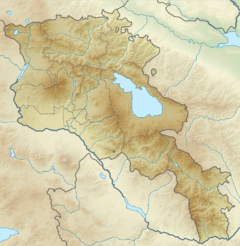


![Canon tables from the Haghbat Gospels, created at Horomos Monastery and soon after given to the Haghpat Monastery; 1211 (Matendaran, MS 6288, fols. 8v–9r).[14][15]](http://upload.wikimedia.org/wikipedia/commons/thumb/e/eb/Canon_tables_from_the_Haghbat_Gospels%3B_1211_%28Yerevan%2C_Matendaran%2C_MS_6288%2C_fols._8v%E2%80%939r.jpg/178px-Canon_tables_from_the_Haghbat_Gospels%3B_1211_%28Yerevan%2C_Matendaran%2C_MS_6288%2C_fols._8v%E2%80%939r.jpg)
![Mural representing Khutlubuga. Church of the Holy Sign. Haghpat Monastery, southern wall. Late 13th century.[6]](http://upload.wikimedia.org/wikipedia/commons/thumb/e/e3/Mural_representing_Khutlubuga._Church_of_the_Holy_Sign._Haghpat_Monastery%2C_southern_wall._Late_13th_century._%28color%29.jpg/61px-Mural_representing_Khutlubuga._Church_of_the_Holy_Sign._Haghpat_Monastery%2C_southern_wall._Late_13th_century._%28color%29.jpg)
![Deesis. Church of the Holy Sign. Haghpat Monastery. Wall painting in the semi-dome. Early 13th century.[16]](http://upload.wikimedia.org/wikipedia/commons/thumb/7/71/Deesis._Church_of_the_Holy_Sign._Haghpat_Monasery.Wall_painting_in_the_semi-dome._Early_13th_century.jpg/154px-Deesis._Church_of_the_Holy_Sign._Haghpat_Monasery.Wall_painting_in_the_semi-dome._Early_13th_century.jpg)
